Agaricus, AgaricAgarikonGhariqoon (Unani) Ku Bai Tie 苦白蹄; A Li Hong 阿里红 (TCM) |

|
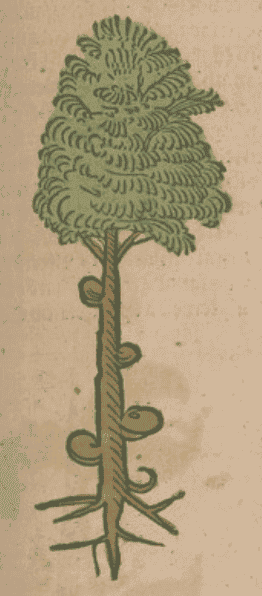 Ortus Sanitatis, Meydenbach, 1491
Ortus Sanitatis, Meydenbach, 1491
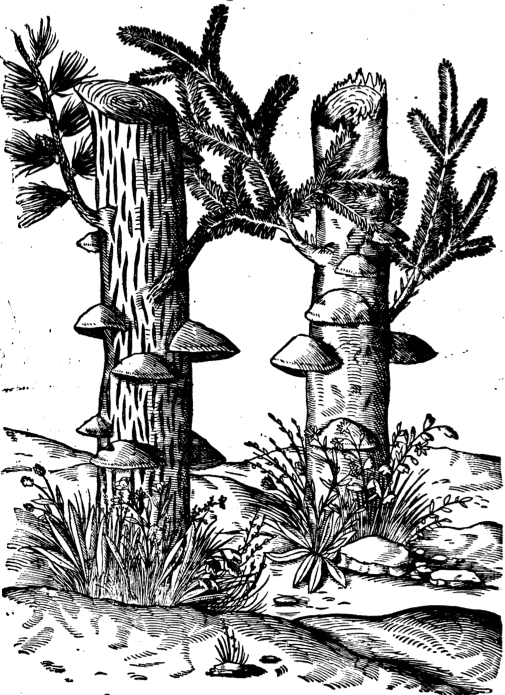
|
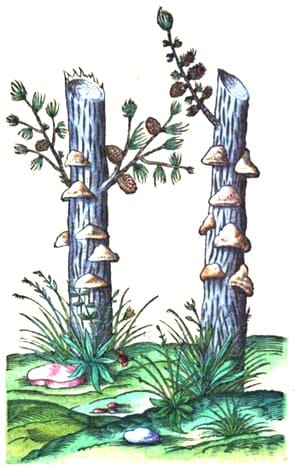
|
|
True ‘Larch Agaric’ New Kreuterbuch, Matthiolus, 1563 |
Agaric Kreutterbuch, Matthiolus, 1586 |
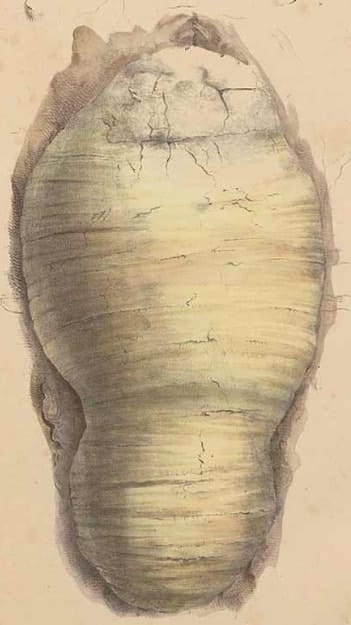
|
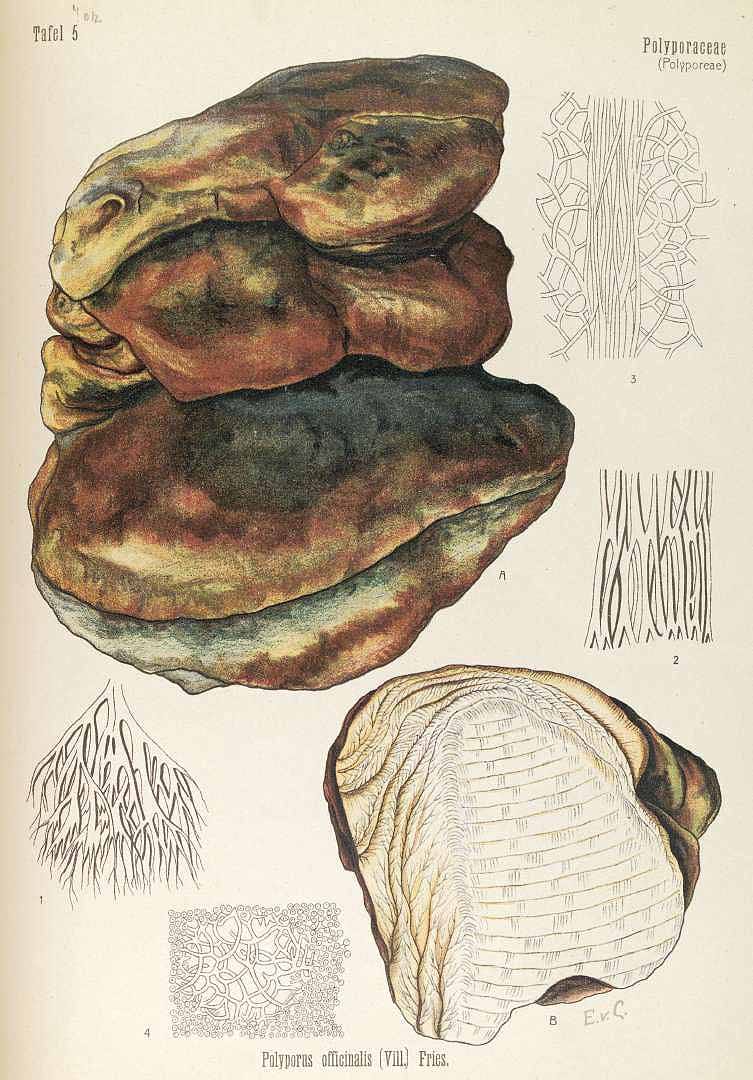
|
|
Polyporus officinalis (Nees von Esenbeck, T.F.L., Plantae officinales, vol. 2, 1828-1833) |
Polyporus officinalis Koehler, F.E., Medizinal Pflanzen, vol. 4 (1890) |
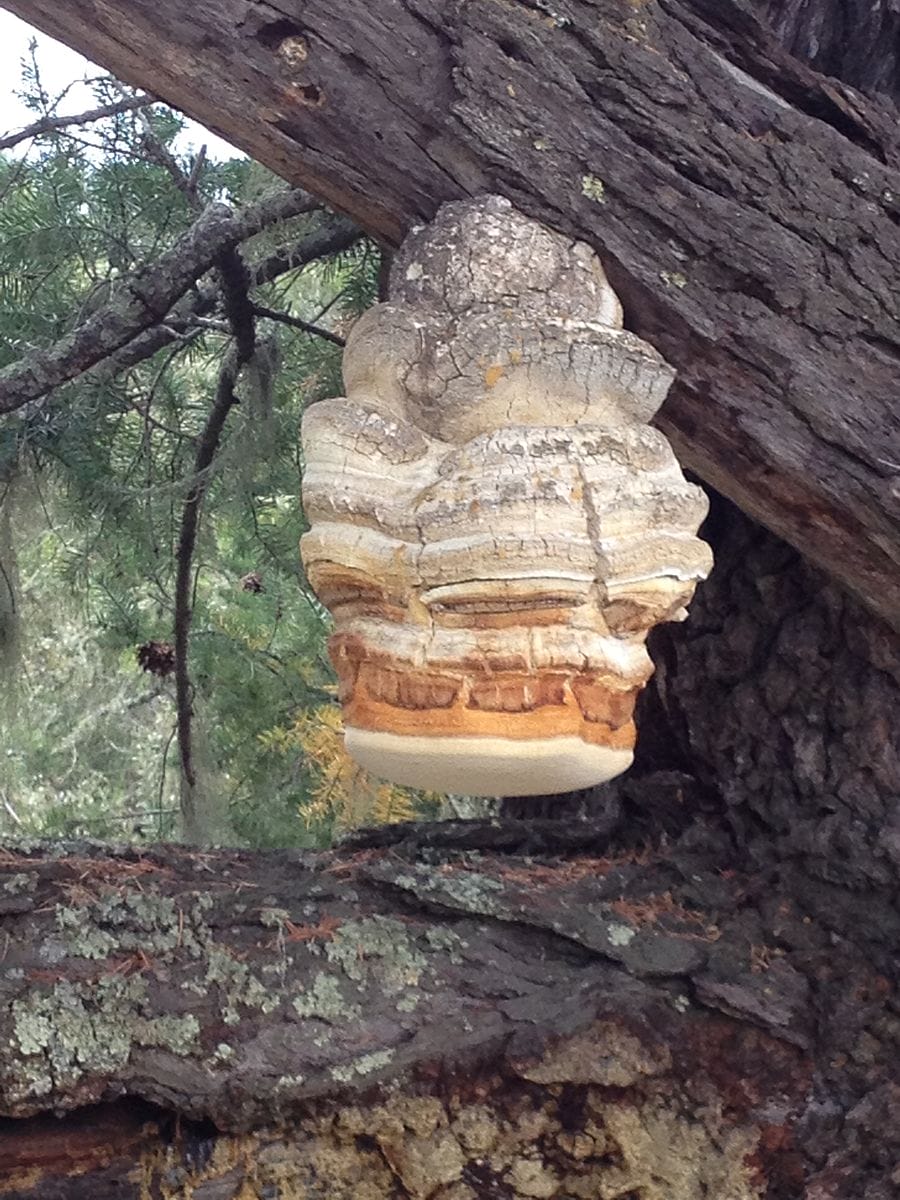 Laricifomes officinalis (as Fomitopsis officinalis)
Laricifomes officinalis (as Fomitopsis officinalis)(Photo by Steph Jarvis) (Wikimedia)
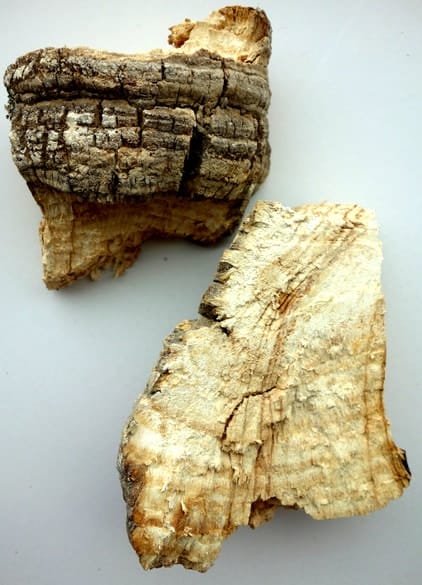
|
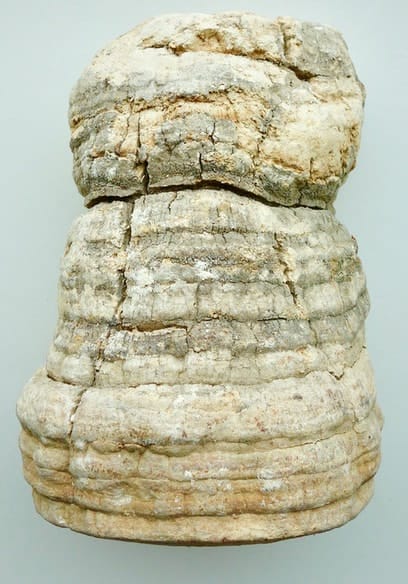
|
 Members CLICK HERE for the PRO VERSION
Members CLICK HERE for the PRO VERSIONBotanical name:
Laricifomes officinalis (syn. Fomitopsis officinalis, Fomes officinalis, Fomes fuscatus, Polyporus officianle, Agaricum officinale, A. alba, Boletus agaricum, B. officinale, B. laricis, B. purgans, Cladomeris officinalis, Piptoporus officinalis, Ungulina officinalis)
Other species listed as sources of Agaric include Fomes fomentarius, Fomitopsis pinicola, Phellinus igniarius
Parts used:
Dried Fungus, preferably collected from Larch trees. The coarse outer coating is removed.
Temperature & Taste:
Mildly Warm (some said Cool), dry; sweet, then bitter
Incides, digests and opens
Classification:
2A APERIENT MEDICINES. 2C INCIDERS. 2F. PURIFYING. 2G. CLEANSING. 2K. RESOLVENT. 2O. ASTRINGENTS
3K. EXPECTORANT.
4d. PECTORAL. 4g. HEPATIC
Preparers and Purgers of Phlegm
Preparers and Purgers of Melancholy
Uses:
1. Dries Damp, Purges Phlegm:
-clears serous and viscous (thick) humors from the whole Body, especially the Mesentery, Head and Lungs
-Edema; obstructed or difficult Urine (West)
2. Purges Melancholy,
-important medicine to purge Melancholy and Burnt Bile
3. Clears Phlegm, Stops Cough and Wheezing:
-Cough, Asthma
4. Clears Wind-Damp, Ease Pain:
-Arthritis, Rheumatism
5. Clears Damp, Settles Wind, Stops Spasms:
-Epilepsy, Vertigo, Dizziness
6. Moves the Blood, Resolves Masses:
-Promotes Menstruation
7. Clears Wind-Heat, Resists Poison:
-Poisons (Dioscorides)
Preparation:
As it is rough on the Stomach, it was prepared with Ginger by Galen, either sprinkling wine or spirit infused with Ginger, or otherwise prepared with Ginger, as in Troches of Agaric.
Dose:
… available in PRO version
Correctives:
… available in PRO version
Substitutes:
… available in PRO version
Main Combinations:
1. To Purge Phlegm and Damp:
i. Agaric with … available in PRO version
ii. Agaric with … available in PRO version
iii. Agaric with … available in PRO version
2. To Purge Phlegm and Bile:
i. Agaric with … available in PRO version
ii. Agaric with … available in PRO version
3. To clear Phlegm from the Lungs:
i. Agaric with … available in PRO version
i. Agaric with … available in PRO version
ii. Agaric with … available in PRO version
iii. Agaric with … available in PRO version
4. Fever, take Agaric with … available in PRO version
5. Cough, Asthma:
i. Agaric … available in PRO version
ii. Agaric … available in PRO version
6. Shortness of Breath, combine Troches of Agaric (2 drams) with … available in PRO version
7. Consumption, Agaric with … available in PRO version
8. Difficulty Urinating, take Agaric with … available in PRO version
9. Urinary Stones, Nephritis, Agaric with … available in PRO version
10. Sciatica, Agaric taken with … available in PRO version
11. Quotidian Fever, Agaric taken with … available in PRO version
12. Hangover (strong morning headache from drinking): … available in PRO version
13. Spleen disease, Agaric with … available in PRO version
14. To Purge Melancholy, combined Agaric with … available in PRO version
15. Fistulas, burnt Salt, Tartar and Agaric … available in PRO version
16. Snake bite, take Agaric … available in PRO version
Major Formulas:
Troches of Agaric (see below)
Infusion to Purge Phlegm (Mesue)
Infusion to Purge Phlegm more Compound (Mesue)
Pills of Agaric (Mesue)
Pills of Agaric (Avicenna)
Pills of Mastic (Mesue)
Pills of Rhubarb and Agaric (Mesue)
Pills for Joint Disease
Pills to Purge Bile and Phlegm (1) (Mesue)
Electuary of Turbith and Agaric
Electuary for Asthma of Andrezeos
Cautions:
1. Large doses cause nauseousness; it is primarily corrected with Ginger and Mastic; also Clove, Cinnamon, Hyssop. The Troches of Agaric (where it is formed into Troches with Wine infused with Ginger) corrects the effect of Agaric.
2. Not used during Pregnancy
3. Not used in dryness or Yin deficiency
4. Large doses can cause Diarrhea, Sweating and Convulsions
5. Not used in Inflammations and Burning Fevers (due to its dryness)
6. Agaric was long known to deteriorate with age, therefore, fresh Agaric is preferred. The Troches are the best way to keep it.
Main Preparations used:
Extract of Agaric, Troches of Agaric
See also:
Agaric from ‘A Treatise on Foreign Drugs’, Geoffroy and Thicknesse, 1749
-
Extra Info
-
Research
-
History
Agaric grows near trees in the form of tubes or boleti which are easy to break, and almost hollow inside. it is very delicate, with a shade of redness to it. The inside is almost white, not unlike bran. initially its taste seems sweet, but slowly this is replaced by an extremely bitter taste. The best agaric is found mainly in Pontus, and though it grows in other places it is much weaker. it has severely loosening properties and helps resist against venomous bites or poisonous drinks. it also purges the stomach a little, and reduces bile and phlegm. it causes no pain or vomiting.
Pharmacographia Indica, Dymock, 1893
| ‘The use of this fungus in medicine is of very ancient date. Dioscorides (iii.,1) describes [?] as male and female, the female being the best and having internally a comb-like structure, whilst the male is convolute, round and compact; both have the same taste, at first sweet, afterwards bitter. He states that it grows in Sarmatia, Galatia in Asia, and Cilicia, and that some suppose it to be a root and others a fungus. It is astringent, hot,and purgative, and is also given in fever, jaundice, nephritis, uterine obstructions, phthisis, dyspepsia, haemorrhage, and pains in the joints; it is alexipharmic. Pliny (25, 57) says: “Agaric is found growing in the form of a fungus of a white colour, upon the trees in the vicinity of the Bosporus. It is administered in doses of four oboli, beaten up in two cyathi of oxymel. The kind that grows in Galatia is generally looked upon as not so efficacious. The male agaric is firmer than the other, and more bitter; it is productive, too, of headache. The female plant is of a looser texture; it has a sweet taste at first, which speedily changes into a bitter flavour.” |
Pereira states that the drug appears in the modern Greek Pharmacopoeia under the name of [?] with the Turkish Synonym of [?]. Ibn Sina insists upon the great efficacy of agaric as an alexipharniic. He and other Mahometan physicians closely follow the Greeks in their description of its medicinal properties; they consider that it removes all kinds of visceral obstructions and expels diseased humors; the female kind should be used after it has been rubbed through a hair-sieve and all black particles removed. The use of agaric in phthisis is of ancient date; it was revived by De Haen, Barbut, and others in the present century, and subsequently decried by Andral (Phil. Trans., Vols. 48 and 49). The active principle, agaricin, has recently been recommended in doses of 1/12 to 1/6 of a grain as an astringent to check night-sweating and diarrhea, to diminish bronchial secretion, and to dry up the milk after weaning’. |
